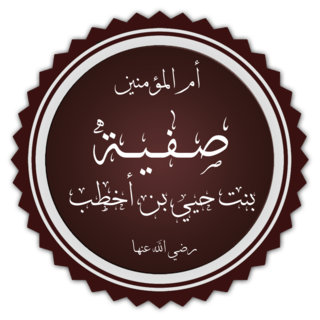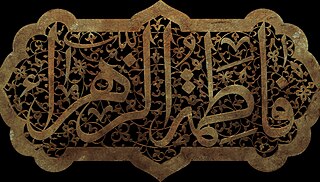Related Research Articles
Muhsin ibn Ali, also spelled Mohsin, was the youngest son of Fatima bint Muhammad and Ali ibn Abi Talib, and thus a maternal grandson of the Islamic prophet Muhammad. He was a brother of Husayn and Hasan. Controversy surrounds the fate of Muhsin as some canonical Shia sources report that Muhsin died in miscarriage, following a raid on her house led by Umar, a companion of Muhammad. Alternatively, Sunnis hold that Muhsin died in infancy of natural causes.
Hafsa bint Umar was the fourth wife of Muhammad and a daughter of the second caliph Umar. In Islamic writings, her name is thus often prefixed by the title "Mother of the Believers".

Safiyya bint Huyayy was a Jewish woman from the Banu Nadir tribe. After the Battle of Khaybar in 628, she was widowed and taken captive by the early Muslims and subsequently became Muhammad's tenth wife. Like all other women who were married to Muhammad, Safiyya was known to Muslims as a "Mother of the Believers". Their marriage produced no children and ended with Muhammad's death in Medina in 632.
Fāṭimah bint ʿAmr was the grandmother of Muhammad and Ali ibn Abi Talib and one of the wives of Abd al-Muttalib ibn Hashim. She was from the Banu Makhzum clan of the Quraysh tribe, unlike her co-wives, most of whom were from outlying tribes and had relatively little influence in Mecca. One of her co-wives, however, was from the Banu Zuhrah clan of the Quraysh.
A muhaddith is a scholar specialized in the study, collection, and interpretation of hadiths, which are the recorded sayings, actions, and approvals of the Prophet Muhammad. The role of a muhaddith is central to the science of hadith, a key field for understanding and preserving Islamic teachings and laws. Muhaddith can either disseminate the hadiths or compile them into an ahadith.

Hadith sciences consists of several religious scholarly disciplines used by Muslim scholars in the study and evaluation of the hadith. The hadith are what most Muslims believe to be a record of the words, actions, and the silent approval of the Islamic prophet Muhammad as transmitted through chains of narrators. Hadith sciences scholars have aim to determine which of these records are authentic, and which may be fabricated.
Abū Dujāna Simāk bin Kharasha was a companion of Muhammad and a skilled swordsman who is mentioned in Hadith narrations from the six major Hadith collections of Sunni Islam.

Fatima bint Muhammad, commonly known as Fatima al-Zahra', was the daughter of the Islamic prophet Muhammad and his wife Khadija. Fatima's husband was Ali, the fourth of the Rashidun Caliphs and the first Shia Imam. Fatima's sons were Hasan and Husayn, the second and third Shia Imams, respectively. Fatima has been compared to Mary, mother of Jesus, especially in Shia Islam. Muhammad is said to have regarded her as the best of women and the dearest person to him. She is often viewed as an ultimate archetype for Muslim women and an example of compassion, generosity, and enduring suffering. It is through Fatima that Muhammad's family line has survived to this date. Her name and her epithets remain popular choices for Muslim girls.
Aisha bint Abi Bakr was the Islamic prophet Muhammad's third and youngest wife.
The Shi'a view of Aisha is generally unfavourable. This is primarily due to what they see as her contempt for the Ahl al-Bayt and her actions in the First Fitna of the time. Her participation in the Battle of the Camel is widely considered her most significant sign of such contempt. Shi'a also consider Aisha to be a controversial figure because of her political involvement during her lifetime. Aisha came from a political family lineage, as she was the daughter of Abu Bakr, the first caliph. Aisha also played an active role in Muhammad's political life; she was known to accompany him to wars, where she learned military skills, such as initiating pre-war negotiations between combatants, conducting battles, and ending wars.

ʿAbd Allāh ibn ʿUmar ibn al-Khaṭṭāb, commonly known as Ibn Umar, was a companion of the Islamic prophet Muhammad and a son of the second Caliph Umar. He was a prominent authority in hadith and law. He remained neutral during the events of the first Fitna (656–661).
Fakhr-un-Nisa Shuhdah Umm Muhammad al-Baghdadiyyah or Shuhdah al-Baghdadiyyah was a Kurdish scholar, muhaddith and a calligrapher. Shuhdha was called "the calligrapher, the pride of womanhood, a muhaddithah of Iraq with a high Isnad."
Umm al Darda as Sughra al Dimashqiyyah or Umm al Darda the Younger, was a 7th-century jurist and scholar of Islam in Damascus and Jerusalem. She is not to be confused with Umm al-Darda, wife of the sahaba Abu Darda.
Fāțima bint Ibrahim ibn Mahmūd al-Bațā'ihiyya also known as Fatima al-Batayahiyyah was a Muslim scholar of hadith in the 8th century.
Fatima bint al-Mundhir ibn al-Zubayr (668–763) was a hadith scholar from Medina, who belonged to the generation of tabi'un. She is a prominent Hadith narrator within Sunni Hadiths.
Sitt al-Wuzara' al-Tanukhiyyah was a Syrian hadith scholar. She was the last student of Husayn ibn al-Mubarak al-Zabidi and Abu al- Munajja Ibn al-Latti. Alongside with her prominent predecessors -Umm al-Darda and Fatima bint 'Abd al- Malik ibn Marwan, wife of the pious caliph 'Umar ibn 'Abd al-'Aziz, she is represents what Mohammad Akram Nadwi terms as hadith scholarship from al-Sham.
Fatima bint Muhammad ibn Ahmad al-Samarqandi was a twelfth-century Muslim scholar and jurist.
Fāṭima bint Abī ʿAlī al-Ṣadafī (1114/5–1193) was a learned woman of al-Andalus.
References
- ↑ Suḥub al-wābilah 'alá ḍarā'iḥ al-Ḥanābilah by Ibn Ḥumayd 3/ 1227
- ↑ Suḥub al-wābilah 'alá ḍarā'iḥ al-Ḥanābilah by Ibn Ḥumayd 3/ 1228
- ↑ Farooq, Dr. Mohammad Omar; Siddiqi, Dr. Muhammad Zubayr. "Women Scholars of Hadith". Women Scholars of Islam: They Must Bloom Again. Archived from the original on 7 July 2015. Retrieved 10 February 2015.
- 1 2 3 Siddiqi, Muhammad Zubayr (1993). "Hadith Literature Its origin, development and special features: Women Scholars of Hadith". The Islamic Texts Society Cambridge: 117–123. Retrieved 23 February 2015.
- 1 2 3 Nadwi, Mohammad Akram (2007). Al Muhaddithat: the women scholars in Islam. London: Interface Publishers. p. 263.
- ↑ "Amazing Women Scholars". The True Knowledge. Archived from the original on 2 April 2015. Retrieved 2 March 2015.